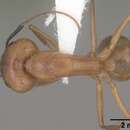en
names in breadcrumbs


Taxonomic history
Wheeler, 1910g PDF: 312 (s.m.); Wheeler & Wheeler, 1970b PDF: 651 (l.).Combination in Camponotus: Dalla Torre, 1893 PDF: 231.Combination in Camponotus (Myrmoturba): Wheeler, 1917a PDF: 561.Combination in Camponotus (Tanaemyrmex): Emery, 1925d PDF: 80.Subspecies of Camponotus fumidus: Wheeler, 1902g PDF: 22; Creighton, 1950a PDF: 376.Status as species: Snelling, 1968b PDF: 350; Snelling, 2006 PDF.Senior synonym of Camponotus fumidus pubicornis: Wheeler, 1910g PDF: 312.Senior synonym of Camponotus fumidus spurcus: Creighton, 1950a PDF: 376.[Note: senior synonym of †Paleosminthurus juliae Camponotus juliae Pierce & Gibron, 1962: Snelling, R.R. (pers. comm. to B. Bolton, 2004, unpublished, unconfirmed).].Camponotus festinatus is a species of carpenter ant that is typically found in the Southwestern United States and northern reaches of Mexico.[1] It is most commonly found around Tucson, Arizona. It lives in the semi-dead branches of palo verde trees found in the area. Camponotus festinatus is an exclusively liquid feeder. These ants can only feed on sap from trees or the juices of a deceased animal. Like most ants, their diet is primarily sugar with some protein. Camponotus festinatus ants are not known to be aggressive except towards other ants. Soldiers will prefer to run from humans rather than be aggressive. In principle, these ants can bite with their mandibles. However, as carpenter ants like these are formicines, they have no functional sting. Instead of stinging, they can use an acidopore to spray formic acid.[2]
C. festinatus queens are 'claustral foundresses', in that they sequester themselves in a chamber to begin a new colony and raise the first set of worker ants without seeking out or obtaining additional food.[3]
Camponotus festinatus is a species of carpenter ant that is typically found in the Southwestern United States and northern reaches of Mexico. It is most commonly found around Tucson, Arizona. It lives in the semi-dead branches of palo verde trees found in the area. Camponotus festinatus is an exclusively liquid feeder. These ants can only feed on sap from trees or the juices of a deceased animal. Like most ants, their diet is primarily sugar with some protein. Camponotus festinatus ants are not known to be aggressive except towards other ants. Soldiers will prefer to run from humans rather than be aggressive. In principle, these ants can bite with their mandibles. However, as carpenter ants like these are formicines, they have no functional sting. Instead of stinging, they can use an acidopore to spray formic acid.
C. festinatus queens are 'claustral foundresses', in that they sequester themselves in a chamber to begin a new colony and raise the first set of worker ants without seeking out or obtaining additional food.